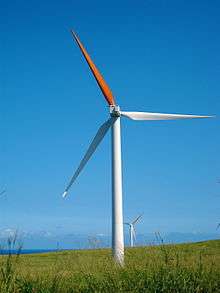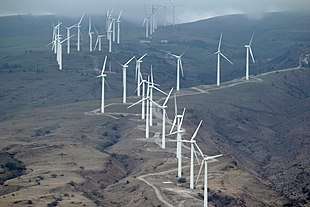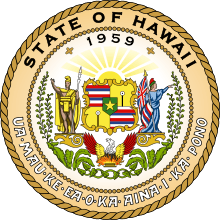Energy in Hawaii

Energy production in Hawaii is a difficult issue due to the islands' isolated location and lack of local resources. The state relies heavily on imports of petroleum and coal for power although recent initiatives have increased use of alternative resources. Hawaii is the state with the highest share of petroleum use in the United States, with nearly 70% of electricity coming from oil in 2015.[1] As of 2016, 26.6% of electricity is from renewable sources.[1]
Hawaii has the most expensive electricity prices in the United States. In 2016 the average cost of electricity was $0.24 per kilowatt-hour, with the next highest state being Alaska at $0.19. The U.S. average was $0.10 per kilowatt-hour across all sectors.[2]
Consumption
Hawaii's primary energy consumption is dominated by oil, which represented 85.0% of primary energy in 2008. This is down from 99.7% in 1960. Other sources in 2008 included coal (7.1%) and renewable energy (7.8%). In 2008, sources of renewable power were:
- 4.0% biomass (down from 8.7% in 1989)
- 1.7% geothermal power
- 0.3% hydropower
- 0.9% solar power
- 0.8% wind power
Renewable sources provided 10.5% of total electric power in 2010.[3] Hawaii ranked third among U.S. states in geothermal energy and seventh in distributed solar power.[4][5] Renewable energy share of electricity generation increased to 26.6% in 2016, with the largest contributors being solar, wind and biomass.[1]
A project by Hawaii Gas would bring liquefied natural gas in container-sized loads in 2015 and by ship-loads by 2019.[6] This gas would be used for Hawaii Gas's synthetic natural gas operation and could also be used for electrical generation.
Government support for renewable energy
Legislation
Hawaii Governor Linda Lingle has approved a number of energy-related bills to address climate change and promote local renewable energy production. The governor's energy bill-signing streak started in late April 2008 with the approval of House Bill 2502, which allows solar energy facilities to be located on less-productive agricultural lands, followed in late May by the approval of HB 3179, which makes it easier for biofuel producers to lease state lands. In the same time frame, the governor approved SB 2034, SB 3190, and HB 2168, which authorize special purpose revenue bonds to help finance a 2.7-megawatt wave energy facility off the coast of Maui, a solar energy facility on Oahu, and hydrogen generation and conversion facilities at the Natural Energy Laboratory of Hawaii Authority, located on the island of Hawaii.
Solar water heaters have long been a common appliance with a 2010 law requiring them in new construction. Senate Bill 644, approved on June 26, 2008 prohibits the issuing of building permits for new homes without solar water heaters as of 2010. The bill excludes homes located in areas with poor solar energy resources, homes using other renewable energy sources, and homes employing on-demand gas-fired water heaters. The bill also eliminates solar thermal energy tax credits for those homes.[7]
On June 6, 2008 the governor approved SB 988, which allows the Hawaii Public Utility Commission to establish a rebate for solar photovoltaic electric systems, and HB 2550, which encourages net metering for residential and small commercial customers.
On July 1, 2008 the governor approved the final three energy bills, including HB 2863, which provides streamlined permitting for new renewable energy facilities of at least 200 megawatts in capacity. HB 2505 creates a full-time renewable energy facilitator to help the state expedite those permits, while a third bill, HB 2261, will provide loans of up to $1.5 million and up to 85% of the cost of renewable energy projects at farms and aquaculture facilities.
Hawaii Clean Energy Initiative
On January 28, 2008, the State of Hawaii and the US Department of Energy signed a memorandum of understanding [8] and announced the Hawaii Clean Energy Initiative, which has a goal to use renewable resources such as wind, sun, ocean, geothermal, and bioenergy to supply 70 percent or more of Hawaii's energy needs by 2030 and to reduce the state's dependence on imported oil.[9][10]
The Initiative's efforts will focus on working with public and private partners on several clean energy projects throughout the state including: designing cost-effective approaches for 100 percent use of renewable energy on smaller islands, designing systems to improve stability of electrical grids operating with variable generating sources, such as wind power plants on the Island of Hawaii and Maui, and expanding Hawaii's capability to use locally grown crops as byproducts for producing fuel and electricity.[11] An inter-island power cable has been proposed as a way of balancing the grids which are currently separated.[12] With an inter-island cable, the proposed Lanai Pumped Storage Project would capture intermittent wind energy and generate power on demand.
Partners include United States Department of Energy - EERE, the state of Hawaii, Hawaiian Electric Company, Phoenix Motorcars and Better Place.
Natural Energy Laboratory of Hawaii Authority
The Natural Energy Laboratory of Hawaii Authority is a test site for experimental renewable energy generation methods and pilot plants for them. Originally built to test Ocean thermal energy conversion (OTEC), it later added research into other sustainable uses of natural energy sources such as aquaculture, biofuel from algae, solar thermal energy, concentrating solar and wind power.
Energy use by sector
Transportation
A transition from fossil fuel vehicles to electric vehicles would enable Hawaii's transportation needs to be fueled with electricity generated from renewable energy and with biofuels.[13][14]
The production of ethanol fuel in Hawaii based on fallow sugar cane fields and algae has been proposed but the efforts have not been successful due to the volatile prices of both oil and ethanol. The state requires 10% ethanol (E10) in automotive fuel.
The Honolulu Rail Transit network, expected to begin operation in late 2020,[15] will be operated by autonomous electric trains.[16][17]
Electricity
_estimated_monthly_electricity_generation_(Jan_2014-Dec_2016)_(42753184704).png)
95% of the population in Hawaii is supplied by Hawaiian Electric Industries. The island of Kauai is the only island in the state not supplied by HEI. Instead, the consumer-owned Kauai Island Utility Cooperative manages that island's electricity. As of 2018, the total dispatchable capacity is 1,727 MW, and the intermittent generation capacity is 588 MW.[18] The islands lack a single grid as there are no underwater cables.[19]
Oil
Most of the electricity in Hawaii is produced from oil.
Solar power
Solar power in Hawaii grew quickly as photovoltaic panel prices dropped putting household energy generation below the cost of purchased electricity. In 2013, Hawaii was second only to Arizona in per capita solar power and about 10% of Oahu customers had solar panels. Several utility scale solar farms exist along with distributed household generation. In 2016 the state had a total of 674 MW of capacity.[20]
The island of Kauai has an abundance of solar energy, and batteries are being installed to permit the energy to be used at night.[21]
Wind power

Wind power in Hawaii has the potential to provide all of the electricity used in the U.S. state of Hawaii. The 114 commercial wind turbines in the state have a total capacity of 206 MW. In 2013, they produced 5.1% of Hawaii's electricity.[22] In 2012, Hawaii generated 367 million kWh from wind power.[23]
Hawaii began research into wind power in the mid-1980s with a 340 kW turbine on Maui, and the 2.3MW Lalamilo Wells wind farm on Oahu and the 9MW Kamaoa wind farm on the Big Island of Hawaii .[24] The MOD-5B, a 3.2MW wind turbine, on Oahu was the largest in the world in 1987. These early examples were all out of service by 2010.
Biomass
Hawaii has several biomass electric plants included the 10MW Honolulu International Airport Emergency Power Facility, the 6.7MW Green Energy Agricultural Biomass-to-Energy Facility on Kauai, and the 6.6MW waste-to-energy Honua Power Project on Oahu. The 21.5 MW Hu Honua plant is expected to be online in 2016.[25] Wärtsilä is selling a 50MW system to Hawaii Electric to be installed at Schofield Barracks Army Base on Oahu by 2017. The plant can run on a variety of solid or gas fuels including biomass.[26]
Coal
Hawaii has banned new coal plants[27] beyond the only operating coal-fired power plant in the state, AES Hawaii Power Plant, which generates 180 MWe.[28]
Wave power
The U.S. Navy and the University of Hawaii operate a Wave Energy Test Site in Kaneohe Bay.[29]
Geothermal
The Puna Geothermal Venture was constructed on the island of Hawaii between 1989 and 1993. It operated until May 2018 when it was shut down due to the 2018 lower Puna eruption.
Algae fuel
Cellana produces oil from algae at a 2.5 hectares (6.2 acres) research site at Kailua-Kona on the island of Hawaii. Microalgae have significant potential as an energy crop, with the levels of oil production per acre potentially far exceeding the levels found in vegetable oil crops. Cellana (previously called HR BioPetroleum) worked with Royal Dutch Shell on a pilot facility to grow algae on land leased from the Natural Energy Laboratory of Hawaii Authority, which is located on the west shore of the island of Hawaii.
See also
References
- 1 2 3 "Hawaii Energy Facts & Figures" (PDF). Hawaii State Energy Office. Retrieved 16 November 2017.
- ↑ U.S. Energy Information Administration. Electric Power Monthly, Table 5.6.A. Average Price of Electricity to Ultimate Customers by End-Use Sector by State, October 2016 and 2015, December 23, 2016.
- ↑ http://files.hawaii.gov/dbedt/economic/data_reports/reports-studies/energy-data-trend-2011.pdf
- ↑ State of States 2009 analysis, National Renewable Energy Laboratory
- ↑ Electricity Generation from Renewable Energy in Hawaii, Office of Energy Efficiency and Renewable Energy, U.S. Department of Energy
- ↑ Hawaii Gas moves forward with plans to begin bulk shipment of LNG to Hawaii, Duane Shimogawa, Pacific Business News, Feb 3, 2015
- ↑ Homebuilders skirt solar law More than 20% of new homes use loophole to avoid adding solar, Honolulu Star Advertiser, Alan Yonan Jr., Jan 09, 2011
- ↑ http://apps1.eere.energy.gov/news/pdfs/hawaii_mou.pdf
- ↑ http://www1.eere.energy.gov/office_eere/hawaii_clean_energy.html
- ↑ "Archived copy". Archived from the original on 2013-01-27. Retrieved 2012-08-19.
- ↑ http://news.xinhuanet.com/english/2008-01/31/content_7529675.htm
- ↑ https://energy.hawaii.gov/wp-content/uploads/2012/02/Inter-Island-Undersea-Cable-System-Handout-ver.2.pdf
- ↑ "Electric Vehicles | Honolulu Clean Cities". Archived from the original on 10 September 2013. Retrieved 23 July 2013.
- ↑ Watson, Sterling. "A Fifteen Year Roadmap toward Complete Energy Sustainability - Hawaii as an example". Retrieved 23 July 2013.
- ↑ "Rail Facts - All FAQ's | Honolulu Authority for Rapid Transportation". Retrieved 4 January 2018.
- ↑ "Doing Business with HART | Honolulu Authority for Rapid Transportation". Retrieved 4 January 2018.
- ↑ "Honolulu Is Building America's First Fully Driverless Transit System | Citylab". Retrieved 4 January 2018.
- ↑ https://www.hawaiianelectric.com/about-us/power-facts
- ↑ http://euanmearns.com/can-hawaii-go-100-renewable/
- ↑ Top 10 Solar Energy States Per Capita (US), http://cleantechnica.com/, September 3rd, 2014
- ↑ https://arstechnica.com/information-technology/2017/03/kauai-is-moving-from-diesel-generators-to-renewable-energy-with-help-from-tesla/
- ↑ , American Wind Energy Association
- ↑ Electric Power Monthly February 2013 Table 1.17.B.
- ↑ Wind Energy, Hawaiian Electric Company, 2013
- ↑ Work resumes at Hu Honua; CEO: ‘We are now fully back on site’ Archived 2015-02-05 at the Wayback Machine., West Hawaii Today, January 15, 2015
- ↑ Wartsila to provide 50 MW plant to bioenergy project in Hawaii, Biomass Magazine, Erin Voegele, December 02, 2014
- ↑ "Archived copy". Archived from the original on January 27, 2013. Retrieved August 19, 2012.
- ↑ "Existing Electric Generating Units in the United States, 2006" (Excel). Energy Information Administration, U.S. Department of Energy. 2006. Retrieved 2008-07-14.
- ↑ THE NAVY AND PRIVATE COMPANIES COLLABORATE TO TURN WAVE ENERGY INTO ELECTRICITY, Hawaii Business, Beverly Creamer, July, 2014
